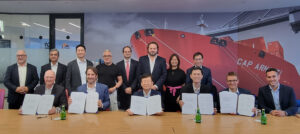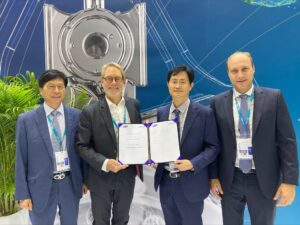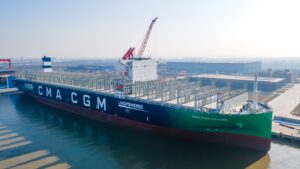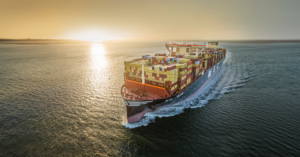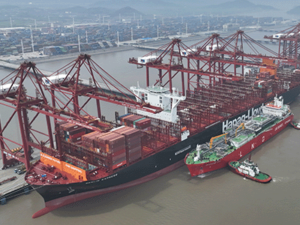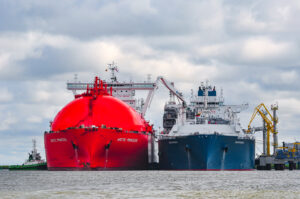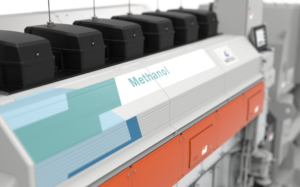Methane slip is back making headlines thanks to video footage released by green European lobby group Transport & Environment, evidence it says of large amounts of damaging methane coming out of the funnels of LNG-powered vessels. Claims that have been dismissed by Sea-LNG which says there are more realistic reports coming out soon that will give a true picture of emissions.
Transport and Environment, the Brussels-cased lobby group, has long been against shipping’s transition to using liquid natural gas as a marine fuel. It’s campaign to get stronger regulation from both the European Union and the International Maritime Organization has been based around the fact that LNG still produces significant CO2 emissions when burned, though less than current bunker fuels, and more importantly often comes with methane slip, when unburned methane goes through the engine and out the ship’s funnel into the atmosphere.
Methane is 80 times worse a greenhouse gas than CO2, which makes it an important gas to reduce emissions of.
Shipping is turning to using LNG, with claims of vessels being green and environmentally friendly as a result. Methane slip has been known about for decades, and engine makers have said they have been tackling methane slip from their power units as well minimising methane emissions to the air.
This year will see one of the highest numbers of LNG-powered newbuildings delivered into the global fleet with more expected during 2023. Many owners eye the coming emissions regulations such as the CII and EEXI as pushing them to discard older vessels and order new efficient ones, the current favourite option being LNG power.
Now a new report and evidence from Transport & Environment suggests methane slip is far worse than industry is led to believe. T&E has issued a report, along with videos using a infrared camera it says can detect the presence of methane emissions form ships. The footage was filmed in Rotterdam, with a focus on two vessels, an LNG powered dredger and a large CMA CGM gas powered containership at berth.
The images, seen in a documentary like video from the group shows plumes of gas which T&E says are evidence of methane escaping through the ships exhaust. The cameras pick up the heat as hot gases are emitted from the funnels of gas-powered ships, which is to be expected, but say the plumes of cooler gas that can be easily seen further away from the funnels are evidence of unburned natural gas, or methane, which goes straight into the atmosphere.
No evidence to back this up
Industry lobby group SEA-LNG, whose members include shipowners, engine makers and technology firms with gas solutions has however dismissed the T&E report arguing that the information the green group provides lacks details.
“What we’ve seen of what they have published…veer on the side of sensationalism,” argued Steva Esau SEA-LNG Chief Operating Officer
“They make a range of claims that the images, indicate high levels of methane slip, but they don’t provide any quantification. They mention a peer reviewed report, but they don’t give access to it”
He added that there are no indication of the operating conditions of the vessels. In the video published by Transport & Environment it is however clear that the vessels filmed were in the port of Rotterdam, and vessels manoeuvring in port conditions which are often when power demands on vessels often vary greatly leading to incomplete combustion.
“So it’s, it’s a statement, which is not backed up with any evidence”
Additionally engine makers have long argued they have been working on ways to reduce methane slip from their engines, either through additional technology such as exhaust gas recirculation or redesigning their engines to meet methane slip challenges which emerged once LNG was seen as a way to reduce some of the CO2 emissions from sipping and not just a clean fuel that met sulphur oxide and nitrous oxide emission standards,
Many vessels are being built with LNG as a new energy source. Natural gas is much cleaner with regards to sulphur oxide emissions, NOx emissions and even particulate matter, but as the gas is still a hydrocarbon will still produce CO2, about 20% less than a standard diesel or fuel oil. But with the methane slip the greenhouse emissions are much worse.
LNG is being labelled a transition fuel, with vessels being able when suitably prepared, to run off electro-LNG fuels made with renewable sources and biofuels. However, in all these cases methane slip could still be present, though in those cases the argument of recycled methane could be used.
T&E wants to see LNG labelled as a hydrocarbon fuel like current bunker fuels and more effort made to create legislation that pushes for more sustainable green fuels.
Esau points out that measuring the emissions from ships should be done across their operating profile to get a tru picture of emissions.
“If you want to step back from this, and you’re fundamentally concerned about the climate impact of shipping, probably where you’d want to start from is where as most of that fuel burned, and under what operating cycles.
So 70% to 80% of the fuel is burned in a deep sea shipping space where you’ve got massive two stroke engines operating at optimal capacity. So that’s where you need to measure the emissions. If you’re really serious about it, and I know that’s a challenge, I can’t say to Transport & Environment to go jump on a ship and go and measure it – I am not sure how welcome they would be able to do this, or even welcome anyone would be to do this.”
This is something he says will come out of some future reports on full emissions, including methane slip, from a couple of reports soon, including one from Queen Mary University’s Westfield College in London soon. Reports which he says will give a true picture of shipping emissions.
























